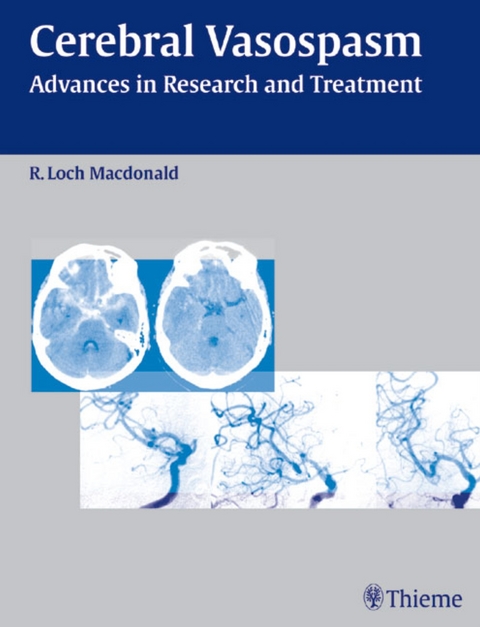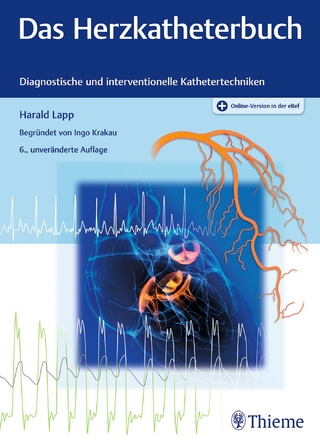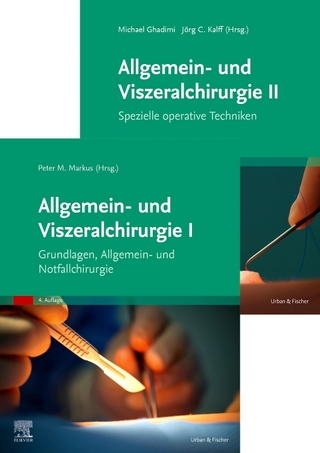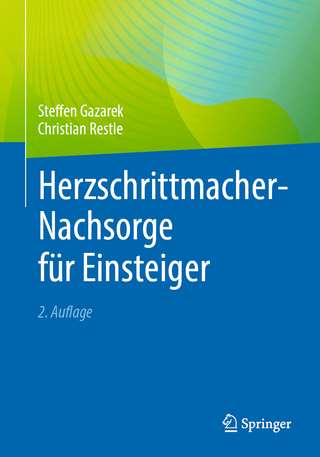
Cerebral Vasospasm
Thieme Medical Publishers Inc (Verlag)
978-1-58890-283-2 (ISBN)
- Titel ist leider vergriffen;
keine Neuauflage - Artikel merken
Special features:
Contributions from top international specialists
Reviews all new clinical and research advances ·Offers authoritative coverage of pathophysiology, experimental treatments, endovascular surgery, and other important management issues
Nearly 200 clear images bring material to life and highlight key concepts
Straightforward text designed for easy readability and quick reference
The study of cerebral vasospasm following aneurysmal subarachnoid hemorrhage has seen great strides in the past decade, leading to significant progress in diagnostic and therapeutic techniques. Offering an incisive summary of these advances, here is the book that all neurosurgeons, vascular specialists, emergency room physicians, and neuroradiologists need for a deeper understanding of this multi-faceted condition.
Head, Division of Neurosurgery, St. Michaels Hospital; Professor of Surgery, University of Toronto, Toronto, Ontario, CanadaCo-Founder and Chief Scientific Officer, Edge Therapeutics Inc.
Section I. Molecular Mechanisms of Vasospasm
1. Signaling Pathways in Cerebral Vasospasm
2. A New Approach to the Mechanism of Smooth Muscle Contraction: Calmodulin Sensor MLC Kinase Mice
3. Changes in Vascular Ion Channels After Experimental Subarachnoid Hemorrhage
4. Inhibition of Src Tyrosine Kinase Reduces Experimental Cerebral Vasospasm
5. Potassium Channels in Experimental Cerebral Vasospasm
6. Sphingosine-1-Phosphate–Induced Arterial Contraction and Ca2+ Sensitization
7. Potential Role of Potassium Channels in Tyrosine Kinase Inhibitor-Induced Vascular Relaxation in Rat Basilar Artery: A Patch-Clamp Study
8. The Role of Calcium-Activated Potassium Channels in the Mouse Model of Chronic Cerebral Vasospasm
9. Protein Kinase C Isoforms, Rho Kinase and Myosin Light Chain Phosphorylation as Mechanisms of Cerebral Vasospasm After Subarachnoid Hemorrhage
Section II. Remodeling and Inflammation
10. Magnesium in Subarachnoid Hemorrhage: Is It That Simple?
11. Pathogenesis of Cerebral Vasospasm: The Role of Cerebral Microcirculatory Changes
12. Bilirubin Oxidation Products and Their Possible Role in Subarachnoid Hemorrhage-Induced Cerebral Vasospasm
13. Activation of Microglia After Experimental Subarachnoid Hemorrhage in Rats
14. Smooth Muscle Phenotype Change in Canine Basilar Artery After Experimental Subarachnoid Hemorrhage
15. Inflammation and Cerebral Vasospasm: New Perspectives
Section III. Experimental—Endothelium
16. Pathophysiology of Delayed Vasospasm After SAH: New Hypothesis and Implications for Treatment
17. Endothelin B Receptor Null Mutation Prevents Subarachnoid Hemorrhage-Induced Cerebral Vasospasm in the Rat In Vivo
18. Experimental SAH Alters Endothelin Receptor Phenotype in Rat Cerebral Arteries
19. Endothelial Dysfunction in a Primate Model of Cerebral Vasospasm
20. Increased Contractile Effect of Endothelin-1 on Isolated Rat Basilar Artery after Experimental Subarachnoid Hemorrhage
21. CSF Levels of ADMA, an Endogenous Inhibitor of Nitric Oxide Synthase, are Associated With Vasospasm After Subarachnoid Hemorrhage
22. Monitoring Activation of Cerebral Endothelin System after Subarachnoid Hemorrhage by Measuring C-terminal Fragment in Cerebrospinal Fluid
23. Cytokines Produce Apoptosis in Cultured Cerebral Endothelial Cells
Section IV. Experimental—Pathophysiology
24. Controversial Issues Regarding the Pathophysiology of Vasospasm: A Review
25. Cerebral Vasospasm Revisited: SAH Syndrome
26. Intravascular Adenoviral Gene Transfection of Monkey Cerebral Arteries Using Micro-Balloon Catheters
27. Oxyhemoglobin Potentiation of Thromboxane A2-Induced Contraction of Porcine Basilar Arteries
28. Cytosolic Calcium Oscillations Induced by Cisternal Cerebrospinal Fluid from SAH Patients
29. Nicotine Exposure Potentiates Vasoconstriction of Canine Basilar Artery via Protein Kinase C Activation and Attenuation of Nitric Oxide Synthesis
30. Experimental SAH Upregulates 5-HT1B Receptors in Rat Cerebral Arteries
31. What Is the Key Factor Expressed in Human Spastic Arteries After SAH?
32. Expression of Hypoxia Inducible Factor-1 in a Rat Subarachnoid Hemorrhage Model
33. Interactive Role of Protein Kinase C Isoforms and Rho Kinase in Vasospasm After Experimental Subarachnoid Hemorrhage
34. Possible Role of Heme Oxygenase-1 and Ferritin in Cerebral Vasospasm After Aneurysmal Subarachnoid Hemorrhage
35. Hypothermia Reduces Metabolic Alterations Caused by Acute Vasospasm After SAH in Rats: A Microdialysis and Magnetic Resonance Spectroscopy Study
Section V. Experimental Treatments
36. Prevention of Experimental Cerebral Vasospasm by Intrathecal Delivery of Liposomal Fasudil
37. Magnesium and Cerebral Vasospasm
38. Phosphodiesterase III Inhibitor for the Treatment of Chronic Cerebral Vasospasm in Dogs
Section VI. Clinical—Doppler and Imaging
39. Intraoperative Microvascular Doppler Sonography for Monitoring Vasospasm and Use of Topical Vasodilators During Intracranial Aneurysm Surgery
40. Basilar Vasospasm Following Aneurysmal Subarachnoid Hemorrhage: TCD and SPECT Correlation
41. Comparison of Positron Emission Tomography Cerebral Perfusion With Transcranial Doppler in Subarachnoid Hemorrhage Patients With Neurological Deterioration
42. Brain Perfusion Computed Tomography in Severe Symptomatic Vasospasm
43. Vasospasm and Regional Brain Perfusion: Correlation between TCD and CT Perfusion Measurement
44. Regional Cerebral Blood Flow Monitoring for the Diagnosis of Delayed Ischemia After Aneurysmal Subarachnoid Hemorrhage
Section VII. Clinical—Medical Aspects
45. Sex and Clinical Cerebral Vasospasm in Yorkshire, UK
46. Factors Influencing Vasospasm After Aneurysmal Subarachnoid Hemorrhage: A Prospective Observational Study in the North of England
47. Grading Scale for Subarachnoid Hemorrhage Based on a Modification of the World Federation of Neurological Surgeons Scale
48. Effect of Inotrope-Induced Blood Pressure Changes on Cerebral Perfusion in Patients With Subarachnoid Hemorrhage: A Positron Emission Tomography Study
49. The Role of Isoprostane in Vasospasm After Aneurysmal Subarachnoid Hemorrhage in Humans: Preliminary Experience
50. S-100B and Neuron Specific Enolase as Predictors of Cerebral Vasospasm and Infarcts After Subarachnoid Hemorrhage
51. The APACHE Score for Early Detection of Cerebral Vasospasm
52. Sequential Changes in Oxyhemoglobin in Fluid Drained from SAH Patients Undergoing Cisternal Irrigation
53. Sex and Racial Factors in the Outcome of Subarachnoid Hemorrhage in Mississippi
Section VIII. Clinical—Medical Management
54. Clinical Trial Dilemmas in Vasospasm
55. Circulating Blood Volume After Subarachnoid Hemorrhage
56. Cerebrovascular Effects of Hypertonic Saline in Poor Grade Patients with Subarachnoid Hemorrhage
57. Panax Notoginseng Saponins for Prevention of Vasospasm and Delayed Ischemic Neurological Deficits After SAH: A Review
58. Effect of Hydrocortisone on Excess Natriuresis in Patients with Aneurysmal Subarachnoid Hemorrhage
59. Safety and Efficacy of the Different Components of Hemodynamic Therapy in Patients with Symptomatic Vasospasm
Section IX. Clinical—Surgery and Endovascular
60. Symptomatic Vasospasm After Early Surgical and Endovascular Treatment of Ruptured Cerebral Aneurysms
61. Endovascular Treatment for Cerebral Vasospasm
62. CSF Drainage for Prevention and Reversal of Cerebral Vasospasm After Surgical Treatment of Intracranial Aneurysms
63. Cerebral Vasospasm is Markedly Reduced by Lumbar Cerebrospinal Fluid Drainage
64. Fenestration of the Lamina Terminalis Reduces Vasospasm After Subarachnoid Hemorrhage from Anterior Communicating Artery Aneurysms
Section X. Clinical—Treatment
65. Clinical Trial of Nicardipine Prolonged-Release Implants for Prevention of Vasospasm
66. Transdermal Nitrogylcerin in Patients with Subarachnoid Hemorrhage: A Pilot Study
67. Decision Analysis in the Treatment of Vasospasm After Aneurysmal Subarachnoid Hemorrhage
68. Effects of Fasudil Hydrochloride, a Protein Kinase Inhibitor, on Cerebral Vasospasm and Infarction
69. Fasudil Hydrochloride for Vasospasm After Early Surgery for Good Grade Patients with Subarachnoid Hemorrhage
70. Analysis of Patients With Cerebral Infarction Caused by Vasospasm After Intra-Arterial Administration of Fasudil Hydrochloride
71. Therapeutic Strategies for Cerebral Vasospasm After SAH: Efficacy of a Combination of Intraventricular Urokinase and Intra-Arterial Fasudil
72. Effects of Intrathecal Fibrinolytic Therapy on Clot Lysis and Development of Cerebral Vasospasm in Patients With Aneurysmal Subarachnoid Hemorrhage Following Endovascular Therapy
73. Intracisternal Thrombolysis With Tissue Plasminogen Activator for Severe Aneurysmal Subarachnoid Hemorrhage
74. Prevention of Vasospasm by Cisternal Irrigation with Urokinase and Ascorbic Acid
75. Prevention of Vasospasm: Surgical Procedures and Postoperative Management in Patients Undergoing Cisternal Irrigation
76. Prevention of Symptomatic Vasospasm by Intermittent Cisternal Irrigation With Urokinase and Ascorbic Acid
| Erscheint lt. Verlag | 18.10.2004 |
|---|---|
| Verlagsort | New York |
| Sprache | englisch |
| Maße | 279 x 216 mm |
| Gewicht | 1232 g |
| Themenwelt | Medizinische Fachgebiete ► Chirurgie ► Herz- / Thorax- / Gefäßchirurgie |
| Medizinische Fachgebiete ► Chirurgie ► Neurochirurgie | |
| Medizinische Fachgebiete ► Innere Medizin ► Hämatologie | |
| Medizin / Pharmazie ► Medizinische Fachgebiete ► Neurologie | |
| ISBN-10 | 1-58890-283-8 / 1588902838 |
| ISBN-13 | 978-1-58890-283-2 / 9781588902832 |
| Zustand | Neuware |
| Informationen gemäß Produktsicherheitsverordnung (GPSR) | |
| Haben Sie eine Frage zum Produkt? |
aus dem Bereich


